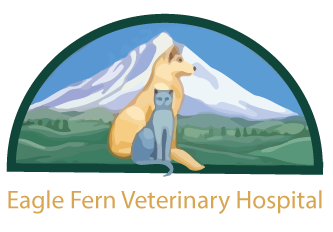 Nutrition for the Growing Dog Nutrition for the Growing Dog
For proper growth and development, puppies have special nutritional needs from weaning to skeletal maturity (12 months for most breeds). Feeding programs for young, growing dogs are best adjusted to the dog's activity level and body condition. Feeding good quality dog food provides complete and balanced nutrition and has been associated with better overall health and decreased risks of certain orthopedic abnormalities when fed appropriately. We recommend Science Diet, Iams or Royal Canin diets. Science Diet has a Canine Growth formulation as well as Canine Growth for large breed dogs whose adult size will be over 55 pounds at maturity.
While all nutrients may influence skeletal development, the amount of food fed, protein and calcium play major roles. When food is fed in excess, the result is a more rapid rate of growth and a greater risk of obesity and skeletal abnormalities such as hip dysplasia. This is especially of concern in the large and giant breed dogs. In general, the best guide of amount to feed is based on physical evaluation. The ribs should be easily felt beneath the skin and an hourglass waist should be present when viewed from above. Limiting intake to maintain these physical parameters will not impede reaching ultimate genetic growth potential. Protein has not been demonstrated to have any negative consequences on calcium metabolism or skeletal development in the dog. A growth diet should contain 28-35% protein (dry matter basis) of high biological value supplying at least 16% of the dietary energy. Dietary protein requirements decrease with age. Calcium levels for a growth diet should be between 1% and 1.6% (dry matter basis). Additional calcium supplements are not necessary and if added will increase calcium to levels shown to increase the risk for developmental bone disease.
To avoid over nutrition from excess consumption and supplementation, routinely weigh your dog and feed the appropriate amount of a good quality food divided into 2-3 meals per day. Free choice feeding may stimulate overeating and increase the risk of developmental bone disease and obesity. At 4 months and 10 months of age the rate of growth slows and the dog will need less food to maintain a good body weight. After dogs have reached 80-90% of their adult size and weight, a free feeding technique may be used. Every two weeks, evaluate body condition by feeling the ribs and observing for a well defined waist. Adjust the amount fed up or down by 10% to maintain a lean, healthy puppy.
A dog's nutritional requirement will decrease after being spayed or neutered. You may need to decrease the amount of food your dog is eating if you notice a weight gain after surgery.
Feeding human food and giving too many treats to your dog is not recommended. If a dog gets too much of these, the diet will be unbalanced and may not provide enough energy and nutrients necessary for optimal body condition and growth. When giving treats consider low calorie treats, fruits (avoid grapes and raisins as they are poisonous to the dog), or vegetables.
After your puppy has reached full maturity at one year of age, switch to a good quality maintenance diet. Consider diets that have dental care qualities. If your dog tends to be overweight, consider feeding it a light (low calorie) formulation. If you have problems keeping weight on your dog, feed an active (high calorie) formulation. Also, have your dog's stool examined for parasites and give de-worming medication your pet to rule out parasites as a cause of low body weight.
If you have questions about the best diet for your dog, consult with our staff or veterinarians.
| 
